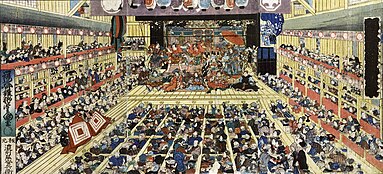
Back كابوكي Arabic Kabuki AST Kabuki Azerbaijani Кабуки Bashkir Kabuki BCL Кабукі Byelorussian Кабукі BE-X-OLD Кабуки Bulgarian কাবুকি Bengali/Bangla Kabuki BS


Kabuki (歌舞伎, かぶき) is a classical form of Japanese theatre, mixing dramatic performance with traditional dance. Kabuki theatre is known for its heavily stylised performances, its glamorous, highly decorated costumes, and for the elaborate kumadori make-up worn by some of its performers. The term kabuki originates from a verb that was used to describe young samurai patrons, meaning "being weird" or "offbeat."[1]
Kabuki is thought to have originated in the early Edo period, when the art's founder, Izumo no Okuni, formed a female dance troupe that performed dances and light sketches in Kyoto. The art form later developed into its present all-male theatrical form after women were banned from performing in kabuki theatre in 1629. Kabuki developed throughout the late 17th century and reached its zenith in the mid-18th century.
In 2005, kabuki theatre was proclaimed by UNESCO as an intangible heritage possessing outstanding universal value. In 2008, it was inscribed in the UNESCO Representative List of the Intangible Cultural Heritage of Humanity.[2]
- ^ Murphy, Taggart (2014). Japan and the Shackles of the Past. New York: Oxford University Press. p. 46. ISBN 978-0190619589.
- ^ "UNESCO – Kabuki theatre".
© MMXXIII Rich X Search. We shall prevail. All rights reserved. Rich X Search